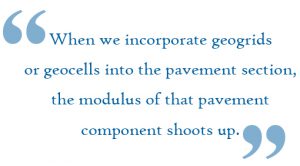
“Strata Has Globally Made An Indelible Mark As An EPC Contractor With All Aspects Of Geosynthetics Under One Roof”
 |
Mr. Shahrokh Bagli Chief Technical Officer, Strata Geosystems |
 |
Strata Geosystems is a leading provider of soil reinforcement technology and many geotechnical solutions in India for over a decade now. Customers count on Strata Geosystems for sustainable, eco-friendly, and cost-effective geotechnical solutions. Mr. Shahrokh Bagli, Chief Technical Officer, Strata in conversation with CE&CR, shares his views on sustainable construction, the techniques being used, geosynthetics in construction, and more.
Civil Engineering and Construction Review: Strata works in numerous sectors in the construction industry. Which sector appeals Strata the most and why?
Shahrokh Bagli: Strata came into business in 2004 as an importer of PET geogrids. With growing business, it commenced manufacture of StrataGrid™ geogrids in 2009 and StrataWeb® geocells in 2012. To ensure that the products are applied to engineering requirements appropriately, Strata executes designs relating to its products and supervisors, and sometimes executes their installation. In the process of executing designs, Strata has experienced the need to provide synergic and holistic solutions. Hence, today Strata has globally made an indelible mark as an EPC contractor with all aspects of geosynthetics under one roof. Beyond the shores of India, the works are executed by contractors with vast experiences in installing geosynthetics, under continuance guidance from the Mumbai Design Office.
We at Strata thrive on challenges. Strata is quite at ease taking up geosynthetic projects, which can be broadly classified as “infrastructure”, ranging from highways to airfields, container yards to heavy vehicle parking lots, from loading platforms to factory/warehouse flooring, from ground improvement to check dams, the scope is vast.
|
CE&CR: Strata is dedicated to sustainability. What efforts are being made to make construction sustainable? Shahrokh Bagli: Strata is leading the effort for sustainable construction using geosynthetics. We have used lakhs of tons of pond ash as a replacement for soil for backfilling highway ramps, using geogrids for retaining walls as compared to conventional RCC walls, which offers substantial carbon savings, using geocells for lining highway slopes and enabling growth of vegetation in place of using quarried stones for conventional stone pitching. We are constantly innovating our products and designs to utilise locally available materials for sustainable construction globally. |
 |
CE&CR: What attempts is Strata making to address the rising demand for geosynthetic products in the Indian and global construction industry?
Shahrokh Bagli: In the very beginning, we introduced geosynthetic products and technology by importing materials. Over the years, we have setup our own manufacturing and very recently quadrupled our manufacturing capacity to cater to the growing demands. With our new Daheli plant, we are meeting both global and domestic market demands with an aim to constantly increase capacity to setup one of the largest geogrid manufacturing facilities in the world.
CE&CR: Geosynthetics is adding value by either reducing the total cost or by prolonging the life of the structures as compared to conventional solutions. Please elaborate.
Shahrokh Bagli: There is indeed value addition with geosynthetics, whichever way you may desire to look at it. Take a simple example of a road, a flexible pavement in our technical parlance. The essential inputs for the design of a flexible pavement are the strength of the subgrade on which the pavement is laid, and the design life of the pavement. The design life is quantified for technical computations as the number of million standard axles that can traverse the pavement before the pavement shows signs of some form of distress. By standard computer software, we calculate stress values and depending on the local costs of the standard pavement components, the section is designed by trial and error.

When we incorporate geogrids or geocells into the pavement section, the modulus of that pavement component where the geosynthetic is placed, shoots up. In that case, the owner has two options:
- It may be decided to maintain the unreinforced section component thicknesses and consider the improvement in the life of the pavement with the increase in the number of million standard axles that can ply over the pavement without causing distress. The period required for maintenance also improves. Hence, the CAPEX may increase but the life cycle cost may reduce.
- Alternatively, the owner may decide to reduce the section and maintain the same number of million standard axles. By this decision, the owner saves on the CAPEX. However, the life cycle costs would remain the same as for an unreinforced section including the need for periodic maintenance like an unreinforced section.
The choice is that of the owner – how to utilise the funds.

CE&CR: What are the advantages of using geosynthetics in the roads sector?
Shahrokh Bagli: The advantages are humungous; but to name a few:
- There are cost savings in normal road construction, as CAPEX and/or OPEX as explained earlier.
- In circumstances where good road making components are not available, local marginal materials such as ash, silty soils, etc. can be used with geosynthetics.
- The Government has mandated the use of Industrial By-Products (IBP) for infrastructure. These can be best used in conjunction with appropriate geosynthetics. IBPs include materials like pond ash, blast furnace slag, etc.
- Speed and quality of construction is more defined as compared to conventional products.
- An emergency condition may require immediate construction of roads, helipads, and airstrips. Geosynthetics can provide an appropriate structure within record time. A typical case is the serious damage to NH-44, the lifeline for Tripura, between Assam and Tripura near Churaibari in 2016. Owing to continuous rains over four months, about 500 m of the highway was damaged and since months, conventional techniques could not rehabilitate the stretch. However, with the use of geocells, the traffic was brought back to normal in a matter of 15 days in spite of repairs being carried out in inclement weather; and the solution was permanent – the stretch of the highway is functioning well even today.
|
CE&CR: You offer three products – StrataGrid, StrataWeb and StrataBase. Please brief us about their demand and market share. Shahrokh Bagli: All these three products are geosynthetics for reinforcement. Depending on design requirements, the three products can be used individually or in conjunction with each other. StrataGrid™ are flexible PET knitted geogrids: StrataWeb® are HDPE three dimensional curvilinear rhomboidal cellular systems that are infilled with soil to form a semi–rigid mat of high modulus. |
 |
Stratabase™ is an extruded PP rigid geogrid: StrataGrid™ individually are extensively used in reinforced soil retaining wall systems and as basal reinforcement for embankments on weak soils. StrataGrid™ individually are used as flexible pavement reinforcement. Depending on design requirements, StrataGrid™ are used along with StrataWeb® geocells as basal reinforcement systems for the embankments. Other applications along with StrataWeb® include reinforcement for paved areas required to carry very heavy loads such as for container yards and heavy vehicle parking lots where traction forces can be high.
StrataWeb® geocells have the characteristic to improve the modulus of the material layer within which they are placed and infilled with. StrataWeb® tend to spread the load over a wider area so that the pressures reduce considerably at the base of the geocell layer. Method of analysis has been derived by Strata. Individually, StrataWeb® has extensive applications in flexible pavements, where even marginal soils can be considered as pavement components. StrataWeb® geocells individually are used as and as basal reinforcement for embankments over weak subgrades. StrataWeb® is also extensively used as fascia systems for reinforced soil walls and as gravity retaining walls with the cells infilled with locally available soils. As an extension to this application, StrataWeb® geocells have been successfully used to construct check dams.
StrataBase™ geogrids are extensively used for railway track strengthening and various other paved applications.
For all these products, the potential demand is quite high as India is undergoing a massive infrastructure development program. The challenge is in the promotion and acceptance of such products and design principles. Having spent substantial efforts over the last decade, we hope to see such products gain in acceptance.
